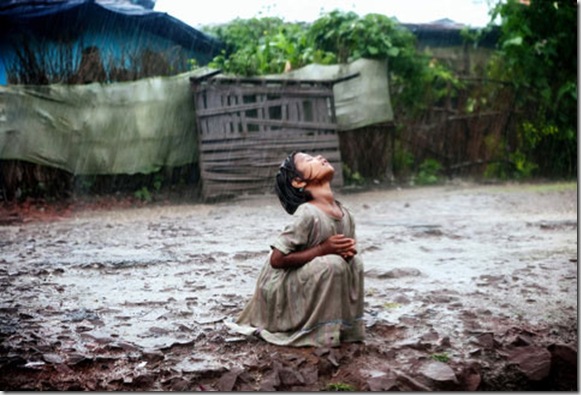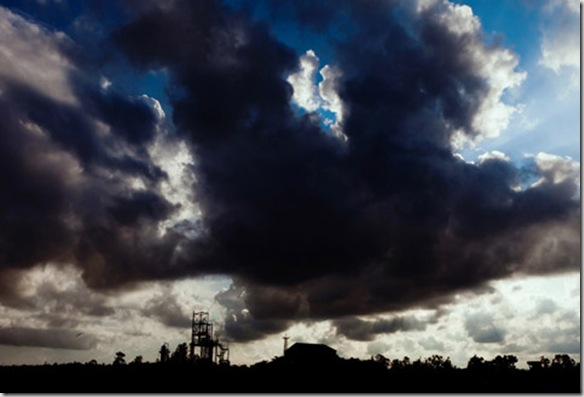
Poonam, 8, is refreshing under the late monsoon rain in the impoverished Oriya Basti colony in Bhopal, Madhya Pradesh, India, near the former Union Carbide (now DOW Chemicals) industrial complex. When the heavy monsoon rain falls every year, it seeps through the buried waste of UC, before proceeding to fill up and pollute the area’s underground reservoirs.
Alex Masi is an Italian documentary photographer and multimedia journalist based in London. His first-ever book “Bhopal Second Distaster” is a witness to the aftermath of the 1984 gas leak, widely thought to be one of the word’s most severe chemical disasters. The book is the stunning and heartbreaking product of the 2012 FotoEvidence Book Award, with an introduction by writer Indra Sinh, full-page color images, and an interview in the back by Svetlana Bachevanova, photographer and publisher at FotoEvidence. The images show the complex reality of lives affected by acute tragedy. “In Bhopal, once I began visiting disabled children, to see the way they and their families lived, it led to looking at how others were coping. I also wanted to show that there was life behind disaster.
 Apesha, 4, is taking part to a physiotherapy session with her mother, a 1984 gas survivor, at Chingari Trust, in Bhopal, Madhya Pradesh. The trust offers assistance, education, physiotherapy and advice to hundreds of children born from gas-affected parents or being fed highly contaminated water since a very early age, when the body is more likely to be affected and to suffer irreparable damage.
Apesha, 4, is taking part to a physiotherapy session with her mother, a 1984 gas survivor, at Chingari Trust, in Bhopal, Madhya Pradesh. The trust offers assistance, education, physiotherapy and advice to hundreds of children born from gas-affected parents or being fed highly contaminated water since a very early age, when the body is more likely to be affected and to suffer irreparable damage. Two children are walking inside one of the large pools once used by Union Carbide (now DOW Chemical) to contain their chemical wastewater, near their now-abandoned industrial complex in Bhopal, Madhya Pradesh, India.
Two children are walking inside one of the large pools once used by Union Carbide (now DOW Chemical) to contain their chemical wastewater, near their now-abandoned industrial complex in Bhopal, Madhya Pradesh, India. Poonam, 8, is walking under the late monsoon rain on a path in the impoverished Oriya Basti Colony, Bhopal, Madhya Pradesh, near the abandoned Union Carbide (now DOW Chemical) industrial complex.
Poonam, 8, is walking under the late monsoon rain on a path in the impoverished Oriya Basti Colony, Bhopal, Madhya Pradesh, near the abandoned Union Carbide (now DOW Chemical) industrial complex. Clouds are rising over the former Union Carbide (now DOW Chemical) factory in Bhopal, Madhya Pradesh, India, site of the infamous 1984 gas disaster.
Clouds are rising over the former Union Carbide (now DOW Chemical) factory in Bhopal, Madhya Pradesh, India, site of the infamous 1984 gas disaster.“It took three days. It was monsoon, with dark clouds hanging over the factory that gave me the idea for the picture, but I had never been in the right place at the right time. The only location to shoot from was a small railway cabin near one of the contaminated colonies. I went each morning and afternoon for about three days. The clouds would melt away, we’d leave, and then I’d see the clouds thickening again, so I’d run back. I knew this would be one of my leading pictures, if I could get it right. I took probably more than 200 pictures from the cabin, experimenting with different zooms, changing angles, waiting and hoping. At some point, everything came together, the clouds were in the best position they could be. Luck comes when all the elements are already in place and you’re waiting prepared.”
 Zubin, 3, is laying in the arms of her mother, a gas victim of the 1984 pesticide disaster, in their home in an impoverished area of Bhopal, Madhya Pradesh, near the former Union Carbide (now DOW Chemical) industrial complex. Zubin has recently deceased.
Zubin, 3, is laying in the arms of her mother, a gas victim of the 1984 pesticide disaster, in their home in an impoverished area of Bhopal, Madhya Pradesh, near the former Union Carbide (now DOW Chemical) industrial complex. Zubin has recently deceased. The control room of Union Carbide (now DOW Chemical) is left in full disrepair inside the abandoned industrial complex in Bhopal, Madhya Pradesh, India
The control room of Union Carbide (now DOW Chemical) is left in full disrepair inside the abandoned industrial complex in Bhopal, Madhya Pradesh, India
.
Since the nearly 30 years since the chemical leak, Bhopal residents have seen many different members of the media. Masi said he worked with two local fixers and that most of those he met understood why he was there to document their community. “I don’t go into someone’s home to get the shot I want, but to work with what’s actually happening there,” he said. “I don’t ask people to do anything they wouldn’t normally do. You can almost post that sort of fakery in the pictures… I want to make images that will touch the emotions of people who see them. To do this I have to allow my own emotions to be touched, and sometimes affected. When I have my camera to my eye, I think only of the picture I’m taking, but technique is useless if I do not feel what these children and families are experiencing. I cannot describe a feeling, just feel it and try to find a visual style that will evoke that feeling when people see my pictures.” Zubin, 3, is portrayed in her usual semi-conscious state on the floor of her home in an impoverished area of Bhopal, Madhya Pradesh, India, near the abandoned Union Carbide (now DOW Chemical) industrial complex. Zubin has recently deceased.
Zubin, 3, is portrayed in her usual semi-conscious state on the floor of her home in an impoverished area of Bhopal, Madhya Pradesh, India, near the abandoned Union Carbide (now DOW Chemical) industrial complex. Zubin has recently deceased. Salman, 13, a child presenting a severe neurological disorder and blindness, is portrayed in his home in the impoverished Arif Nagar colony, Bhopal, Madhya Pradesh, India, near the former Union Carbide (now DOW Chemicals) industrial complex.
Salman, 13, a child presenting a severe neurological disorder and blindness, is portrayed in his home in the impoverished Arif Nagar colony, Bhopal, Madhya Pradesh, India, near the former Union Carbide (now DOW Chemicals) industrial complex.
This post was contributed by photographer Greta Rybus.
Fonte


Nessun commento:
Posta un commento